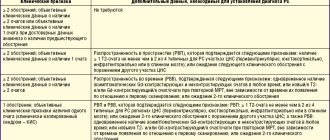Forecast
The prognosis depends on many factors: timeliness of assistance provided, general health, quality of treatment. In addition, the consequences of a stroke depend on the type of stroke, namely the area of the brain affected.
Let's look at the main types of stroke by area and their health consequences.
Major stroke
The outcome for the elderly is unfavorable, since the patient does not fully recover. The result is disability.
Unilateral stroke
The prognosis is influenced by the extent of the lesion and the timeliness of medical care. Often the outcome is death or paralysis. Only in isolated cases does the patient recover completely.
Brainstem stroke
The most dangerous species, often leading to death. The survivors remain disabled.
Cerebellar stroke
The prognosis depends on the extent of the lesion. If treatment is started in a timely manner and the patient is properly cared for during the rehabilitation period, he can fully or partially recover. However, most stroke survivors suffer from impaired mobility, which causes them to walk with support.
Spinal stroke
The prognosis is generally favorable and the mortality rate is low. If treatment is not started in time, the patient can be paralyzed. Problems in the functioning of the pelvic organs cannot be ruled out.
If you are over 80 years old
For people over 80 years of age, the prognosis is rarely good, regardless of the type of stroke. The fact is that at such a respectable age the condition is complicated by existing chronic diseases and weakened immunity, which reduces the chances of recovery.
Elderly people at this age most often fall into a coma, during which they do not breathe on their own. Their blood pressure decreases, which leads to impaired blood circulation. Fever may occur. Lives in a coma for an average of 7 days, after which he dies.
In less severe cases (with a unilateral stroke), the patient remains disabled due to paralysis of the side of the body opposite to the lesion and other disorders.
General information. Indications for surgery
Hemorrhagic strokes are a common, severe neurosurgical disease that represents an acute social problem. Mortality and disability in this pathology to this day remain high both with surgical intervention and with conservative treatment of the patient. The overall mortality rate exceeds 50%; of the surviving patients, about 20% return to their previous work activity. The frequency of hemorrhagic strokes in Russia remains high and amounts to 40–50 people per 100,000 population (about 40,000 hemorrhages per year). The cause of a hemorrhagic stroke can be a rupture of an aneurysm, hemorrhage from a vascular malformation, a complication of surgery, or a complication of a systemic disease (most often, hypertension). In general, about 40% of patients with hemorrhagic stroke require surgical intervention; the rest should be managed conservatively. Indications for surgery are based on the severity of the condition, volume and location of the hematoma. These parameters are usually closely interrelated. By size, hemispheric hematomas are divided into: small (up to 30 ml) medium (30–60 ml) large (more than 60 ml). According to localization, supratentorial hematomas are divided into: lobar (located in the white matter of the cerebral hemispheres; lateral (putamenal; located in the basal ganglia; medial (thalamic). Large hematomas are often mixed. When determining indications for surgery, it is also necessary to take into account the etiology of ICH, the presence and degree of compensation of associated diseases, period after hemorrhage, age of the patient and a number of other factors.
| Hematoma removal is indicated: for hematomas of the cerebral hemispheres of medium and large volume (more than 30 ml) of lobar, lateral or mixed localization, if the patient is not in a comatose state. with cerebellar hematomas accompanied by compression of the fourth ventricle, hydrocephalus or dislocation of the trunk, and/or with the deteriorating condition of the patient. |
| Hematoma removal is not indicated: in the severe condition of the patient, corresponding to a deep or extreme coma (4 points on the Glasgow scale, with the exception of patients with cerebellar hematomas in the acute period of hemorrhage). for small hematomas with minimal neurological impairment. |
For medial hematomas of medium and large sizes, minimally invasive interventions are possible; direct operations are not indicated. In some cases, minimally invasive surgical interventions are performed for small (up to 30 ml) hematomas of deep localization (lateral and medial), accompanied by severe neurological symptoms.
Consequences of a stroke
Unfortunately, as a result of brain damage, important functions are impaired, which are not always amenable to recovery. Let's look at the main ones.
Paralysis
It involves damage to the nerve endings that control muscle function, resulting in loss of motor function. Paralysis can be of the whole body or part of it. The most common form is one-sided. May affect facial muscles.
Speech dysfunction
A common consequence of a stroke that occurs due to damage to the areas of the brain responsible for speech. Expressed in complete/partial loss of the ability to speak and perceive the words of others. With a partial form, the conversation is unclear; with a complete form, there is an inability to utter at least a word.
Deterioration of the visual organs
A stroke can damage the parts of the brain responsible for visual function. As a result, there is deterioration in vision, loss of individual parts from the field of view (up to ½), and strabismus (difficult to treat).
Impaired motor coordination
Most often occurs with a brainstem stroke. Manifests itself in the form of dizziness and staggering when moving. Depending on the form of the pathology and severity, it may manifest itself during the first days after the attack or over a longer period.
Swallowing dysfunction
It occurs due to a disruption of the reflex process or paralysis of facial muscles. It is also a consequence of brainstem infarction.
May manifest:
- Difficulty chewing food.
- Difficulty swallowing food.
- Pain while eating.
- The entry of food particles from the oral cavity into the respiratory organs, in particular the nose.
Formation of bedsores
It is observed in paralyzed patients due to prolonged stay in one position. In this case, less nutrients reach the tissues. The result is their starvation and further death. The areas most affected are areas closely pressed to the bed.
Pneumonia
As a result of paralysis, the patient cannot cough up the mucus that accumulates in the bronchi and enters the lungs. Next, inflammation begins.
Depressive state
The most common consequence that minimizes the effectiveness of treatment and rehabilitation. You need the help of a qualified psychologist and a course of antidepressants.
Coma
One of the dangerous consequences, considered a transitional state to death. During this period it is noted:
- slowing down metabolism;
- decrease in body temperature;
- change in breathing pattern;
- falling into unconsciousness;
- lack of response to external stimuli.
The prognosis for coma is predominantly unfavorable.
Causes of cerebellar stroke
- Blockage of a blood vessel by a thrombus or embolus;
- Rupture of the vessel wall, resulting in hemorrhage and hematoma formation.
- Dissection of a section of the vertebral artery. A very rare phenomenon, due to which a cerebellar stroke is possible in young people.
Impaired blood flow in the cerebellum due to thrombosis is most often observed in patients suffering from other blood pathologies, atherosclerosis. Patients who have recently suffered a myocardial infarction are often at high risk. Thus, blood clots can travel through the bloodstream from the heart into the cerebral arteries.
Hemorrhage in the tissues of the cerebellum is no less dangerous, and it is this that often causes the death of the victim. Blood permeating the brain tissue increases the volume of the hematoma. There is strong pressure on the cerebellar parenchyma, which in turn compresses and displaces the tissue of the brain stem. This is what can lead to sudden death of the patient.
The cerebellum and its functions
Below the occipital hemispheres in the lower part of the skull, close to the spinal column, is the cerebellum. It consists of two hemispheres and a worm. The weight of an adult reaches 160 g. At the time of birth, the child is very small, but is distinguished by noticeable development during the first year of life. By the age of 6 it reaches the minimum size for an adult.
On top, the cerebellum is covered with gray matter, inside it consists of white matter - it contains four nuclei.
Nutrition is provided by three cerebellar arteries, originating from the vertebral and main trunks.
The cerebellum receives information about the current position of the body or its parts. At the same time, an adjustment comes to him from the cerebral cortex regarding what next movement needs to be made. This allows him to correct voluntary and involuntary actions.
The main functions of this part of the brain are coordination of movements, regulation of muscle tone, balance, and muscle memory.
- Stroke on the left side: consequences and features of recovery. How long do people live with this diagnosis?
Causes and prevention of ischemic strokes
Most often, the cause of a cerebral infarction is the movement of a blood clot through an artery and clogging it in a narrow place. A thrombus is a blood clot that is primarily made up of platelets. With normal vascular patency, platelets are responsible for blood clotting, but with atherosclerosis, cholesterol plaques form, narrowing the lumen of the artery, because of this, the usual blood flow is disrupted, side turbulence is formed, and platelets stick together into clots. Also, the cause of the formation of a blood clot can be an increased level of sugar in the blood: when it occurs, microtraumas form in the walls of the artery due to an increase in blood density, which also disrupts normal blood flow.
The cause of a cerebral infarction can also be a narrowing of the lumen of a large artery by more than half. You can read more about this using the example of carotid artery stenosis (note: link to article). When an artery narrows, the blood supply to the brain does not completely stop, so a person often experiences a so-called minor stroke. A minor stroke is similar in symptoms to a regular stroke. Although the degree of damage is much less, this condition requires immediate medical attention: further deterioration of the condition of the arteries can lead to a stroke with all its consequences.
A person cannot influence the movement of a blood clot through the vessels, but everyone can pay attention to a number of risk factors, eliminate them if possible, in order to prevent the formation of a blood clot and minimize the risk of ischemic stroke.
- It is important to undergo a course of treatment and periodically check your condition with a doctor if you have a chronic disease, such as diabetes mellitus, confirmed atherosclerosis, high blood pressure, or various disorders of the heart and blood vessels.
- Experts strongly recommend giving up tobacco and alcohol.
- It is advisable to maintain an active, mobile lifestyle.
- You need to monitor your diet and avoid a strong imbalance towards fats and fast carbohydrates.
The above points are effective measures to prevent not only stroke, but also many other diseases, proven through numerous studies.
But there are also risk factors that we cannot influence. Among them are old age (over 60 years old) and heredity (if immediate relatives suffered a stroke, or they were found to have serious vascular disorders).
Types and symptoms of cerebellar stroke
There are two types of cerebellar stroke: isolated in a certain area and extensive.
Symptoms of isolated cerebellar stroke:
- Disorders of the vestibular apparatus, gait, fine motor skills of the hands;
- Impaired speech and hearing, the victim is unable to pronounce words or make sounds;
- Severe dizziness and nausea;
- Acute pain in the occipital region;
- Coordination of movements and sense of balance are impaired.
Symptoms of extensive cerebellar stroke:
- Acute headache, vomiting and nausea (general cerebral symptoms);
- Coordination of movements and hand motor skills are impaired;
- The patient's speech suffers;
- The patient is unable to maintain balance;
- Respiratory and cardiac functions are impaired;
- The patient is unable to control the functioning of the tongue and make swallowing movements.
If the affected areas occupy more than a third of the volume of both hemispheres of the cerebellum, then such a stroke leads to acute hydrocephalus, which is caused by severe swelling of the damaged tissues. Strong pressure on the brain stem inevitably leads to the death of the victim. This form of stroke requires urgent surgical intervention.
Treatment of cerebellar stroke involves taking the necessary measures as in the treatment of other types of disease. If it is necessary to maintain breathing, then artificial ventilation is performed. Antihypertensive therapy is prescribed for hypertensive patients. For low blood pressure, infusion therapy is used. High fever and aches are eliminated with analgesics and antipyretics. Diuretics relieve cerebral edema. In addition to drug therapy, appropriate care for the patient is organized, including nutrition and prevention of bedsores.
Clinical Brain Institute Rating: 3/5 — 11 votes
Share article on social networks









